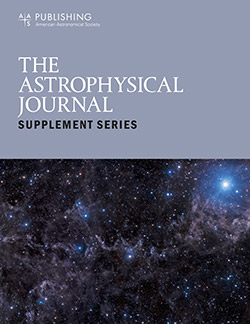35 - 40ghz太阳射电光谱仪的新月和噪声源标定
IF 8.5
1区 物理与天体物理
Q1 ASTRONOMY & ASTROPHYSICS
引用次数: 0
摘要
太阳射电通量的标定一直是太阳学界关注的问题。以前,通量的校准是通过匹配载荷或新月进行相对校准,有时还借助其他台站的数据。此外,频率覆盖很少超过26千兆赫。本文报道了在茶山太阳天文台(CSO)工作的35 ~ 40 GHz的茶山宽带太阳毫米光谱仪(CBS)的升级和校准。最初,太阳辐射亮度温度的定标是以新月为确定源完成的。随后,通过建立太阳射电通量与亮度温度、频率的相关性,得到35 ~ 40ghz的标准通量。最后,利用恒温控制噪声源作为参考,实现了太阳射电通量的标定。2023年2月和3月的定标结果表明,在37.25 GHz下,太阳亮度温度为11,636 K,标准差(STD)为652 K。在35-40 GHz范围内,太阳射电通量强度为~ 3000-4000太阳通量单位(SFU),一致性偏差为±5.3%。粗略估计,系统灵敏度约为~ 5-8 SFU,噪声系数约为200 K,系统在37.25 GHz时传输斜率的变异系数为6.5% @ 12 hr。预计升级后的CBS将在即将到来的太阳活动周期中捕捉到更多的活动。本文章由计算机程序翻译,如有差异,请以英文原文为准。
The Calibration of the 35–40 GHz Solar Radio Spectrometer with the New Moon and a Noise Source
Abstract Calibrating solar radio flux has always been a concern in the solar community. Previously, fluxes were calibrated by matching load or the new Moon for relative calibration, and at times with the assistance of other stations’ data. Moreover, the frequency coverage seldom exceeded 26 GHz. This paper reports the upgraded and calibrated Chashan Broadband Solar millimeter spectrometer (CBS) working from 35 to 40 GHz at the Chashan Solar Observatory (CSO). Initially, the calibration of the solar radiation brightness temperature is accomplished using the new Moon as the definitive source. Subsequently, the 35–40 GHz standard flux is achieved by establishing the correlation between the solar radio flux, brightness temperature, and frequency. Finally, the calibration of the solar radio flux is implemented by utilizing a constant temperature-controlled noise source as a reference. The calibration in 2023 February and March reveals that the solar brightness temperature is 11,636 K at 37.25 GHz with a standard deviation (STD) of 652 K. The solar radio flux’s intensity is ∼3000–4000 solar flux units (SFU) in the range of 35–40 GHz with a consistency bias of ±5.3%. The system sensitivity is about ∼5–8 SFU by a rough evaluation, a noise factor of about 200 K, and the coefficient of variation of the system transmission slope of 6.5% @ 12 hr at 37.25 GHz. It is expected that the upgraded CBS will capture more activity during the upcoming solar cycle.
求助全文
通过发布文献求助,成功后即可免费获取论文全文。
去求助
来源期刊

Astrophysical Journal Supplement Series
地学天文-天文与天体物理
CiteScore
14.50
自引率
5.70%
发文量
264
审稿时长
2 months
期刊介绍:
The Astrophysical Journal Supplement (ApJS) serves as an open-access journal that publishes significant articles featuring extensive data or calculations in the field of astrophysics. It also facilitates Special Issues, presenting thematically related papers simultaneously in a single volume.
 求助内容:
求助内容: 应助结果提醒方式:
应助结果提醒方式:


